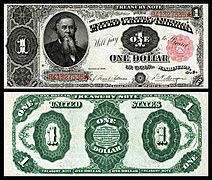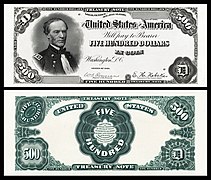Talk:Treasury Note (1890–1891)
| This is the talk page for discussing improvements to the Treasury Note (1890–1891) article. This is not a forum for general discussion of the article's subject. |
Article policies
|
| Find sources: Google (books · news · scholar · free images · WP refs) · FENS · JSTOR · TWL |
| A news item involving Treasury Note (1890–1891) was featured on Wikipedia's Main Page in the In the news section on 17 January 2014. |
| This article is rated B-class on Wikipedia's content assessment scale. It is of interest to the following WikiProjects: | ||||||||||||||||||||||||
| ||||||||||||||||||||||||
Proposal to convert stub-class article to list-class[edit]
Would there be any objection if I worked on turning this stub-class article into a list-class article centering around a table with a complete type set of high resolution scans of 1890 and 1891 notes?-Godot13 (talk) 23:54, 19 December 2013 (UTC)
- Sounds like a good idea to me! --LondonYoung (talk) 20:09, 22 December 2013 (UTC)
- It has more text now, so I've changed it to start class. --ThaddeusB (talk) 04:56, 17 January 2014 (UTC)
Article title[edit]
Hi Godot,
Thank you for contacting me on this issue rather than simply reverting my move. The former title did not conform to Wikipedia's naming conventions, but "Coin Note" is not our only option. The guidelines for choosing article titles when the most common title is ambiguous can be found here. I chose Option #1, "natural disambiguation", which is often the most preferable option, but Option #2 could also work in this case if you are concerned that Option #1 is misleading. Using Option #2, we would create an article title with the format "Treasury Note (disambiguator)" where the word "disambiguator" is replaced by a word or phrase that distinguishes the relevant definition of "Tresury Note" from the other definitions of "Treasury Note" discussed on other articles. What do you think of Treasury Note (Sherman Silver Purchase Act)?
Neelix (talk) 04:35, 19 January 2014 (UTC)
- Wow, that was fast! While "Treasury Note (Sherman Silver Purchase Act)" is probably the most technically accurate, it is quite a mouthful (and wouldn't really fit with the names of the other articles about types of U.S. Banknotes. Would it be odd to call it "Treasury Note (1890/1891)" or "Treasury Note (Series 1890/1891)" ? This is very close to how they are referred colloquially within numismatics, and there is absolutely no mistaking it for any other version of a Treasury Note? Thanks.-Godot13 (talk) 04:42, 19 January 2014 (UTC)
- Oh yeah, what's the point of reverting without finding out why you did it (said a little sarcastically since I know that's how edit wars begin). I believe in asking before shooting... Godot13 (talk) 04:46, 19 January 2014 (UTC)
- It's good to hear that you're not the shoot-first type. :) Having a slash in a parenthetical disambiguator looks strange to me; I've never seen one in use before. Normally, television shows that ran for multiple years are disambiguated solely with the inaugural year and then the class of thing (ex. Spider-Man (1994 TV series)). How about Treasury Note (1890 currency)? Neelix (talk) 04:54, 19 January 2014 (UTC)
- Problem there is that the Treasury Notes were issued in Series of 1890 and 1891. The front is the same design (barring the varieties in signature and seal) but the reverse is complete different. Could we get away with Treasury Note (1890-91)? or possible other variations of the disambiguator: (Series 1890-91), (Series 1890 & 1891)... I'm concerned that beyond adding the date (with or without Series), this could open the door for renaming all U.S. Currency articles. This may or may not be bad, but it could create issues.-Godot13 (talk) 05:08, 19 January 2014 (UTC)
- My preferance would be one of the first two options I mentioned (Coin Note or Treasury Note (Sherman Silver Purchase Act), but if you would prefer Treasury Note (1890-91) and there isn't any other opposition, I won't oppose it. Either way, I'm going to bed, so if you'd like to discuss this further, I won't be able to respond again at least until tomorrow. It was good to virtually meet you! Neelix (talk) 05:19, 19 January 2014 (UTC)
- Problem there is that the Treasury Notes were issued in Series of 1890 and 1891. The front is the same design (barring the varieties in signature and seal) but the reverse is complete different. Could we get away with Treasury Note (1890-91)? or possible other variations of the disambiguator: (Series 1890-91), (Series 1890 & 1891)... I'm concerned that beyond adding the date (with or without Series), this could open the door for renaming all U.S. Currency articles. This may or may not be bad, but it could create issues.-Godot13 (talk) 05:08, 19 January 2014 (UTC)
- It's good to hear that you're not the shoot-first type. :) Having a slash in a parenthetical disambiguator looks strange to me; I've never seen one in use before. Normally, television shows that ran for multiple years are disambiguated solely with the inaugural year and then the class of thing (ex. Spider-Man (1994 TV series)). How about Treasury Note (1890 currency)? Neelix (talk) 04:54, 19 January 2014 (UTC)
- Oh yeah, what's the point of reverting without finding out why you did it (said a little sarcastically since I know that's how edit wars begin). I believe in asking before shooting... Godot13 (talk) 04:46, 19 January 2014 (UTC)
- Wow, that was fast! While "Treasury Note (Sherman Silver Purchase Act)" is probably the most technically accurate, it is quite a mouthful (and wouldn't really fit with the names of the other articles about types of U.S. Banknotes. Would it be odd to call it "Treasury Note (1890/1891)" or "Treasury Note (Series 1890/1891)" ? This is very close to how they are referred colloquially within numismatics, and there is absolutely no mistaking it for any other version of a Treasury Note? Thanks.-Godot13 (talk) 04:42, 19 January 2014 (UTC)
- Good to "meet" you too. If you don't have an objection, my preference would be Treasury Note (1890-91). Thanks-Godot13 (talk) 05:27, 19 January 2014 (UTC)
- I would "vote" for a disambiguator based on year. That is the most natural way to do it to me. (I was also fine with the original title, perhaps as Treasury "Coin" Note instead of Treasury (Coin) Note.) I am indifferent between Treasury Note (1890–91) and Treasury Note (1890/1891). --ThaddeusB (talk) 20:37, 19 January 2014 (UTC)
- Of those three options, I would certainly prefer Treasury Note (1890–91); several move discussions for other articles have made it clear that the community is against including synonyms in article titles. Neelix (talk) 22:09, 19 January 2014 (UTC)
- I would "vote" for a disambiguator based on year. That is the most natural way to do it to me. (I was also fine with the original title, perhaps as Treasury "Coin" Note instead of Treasury (Coin) Note.) I am indifferent between Treasury Note (1890–91) and Treasury Note (1890/1891). --ThaddeusB (talk) 20:37, 19 January 2014 (UTC)
- If there's no objection, in a day or so I'll change the text and title to reflect this discussion.-Godot13 (talk) 05:56, 20 January 2014 (UTC)
- Why not do it this way: "Treasury Note (U.S. Currency)". This would differentiate it from Treasury Note bearer bonds, as bonds are not currency. And it would also immediately point out that it is related to the United States', and not some other country's stuff. Within the context of currency, basically everyone knows what a Treasury Note is, but someone who doesn't know what it is, isn't going to be helped by the highly technical and extraneous information that this Treasury Note, whatever it is, had something to do with 1890-91. --99.7.246.126 (talk) 10:49, 6 March 2014 (UTC)
Featured picture scheduled for POTD[edit]
Hello! This is to let editors know that File:US-$1-TN-1891-Fr-351.jpg, a featured picture used in this article, has been selected as the English Wikipedia's picture of the day (POTD) for August 28, 2022. A preview of the POTD is displayed below and can be edited at Template:POTD/2022-08-28. For the greater benefit of readers, any potential improvements or maintenance that could benefit the quality of this article should be done before its scheduled appearance on the Main Page. If you have any concerns, please place a message at Wikipedia talk:Picture of the day. Thank you! Adam Cuerden (talk)Has about 7.8% of all FPs 13:20, 28 May 2022 (UTC)
The Treasury Note (also known as a Coin Note) was a type of representative money issued by the United States government from 1890 until 1893 to individuals selling silver bullion to the Treasury. A distinguishing feature of the 1890 series of Treasury Notes (and one that greatly appeals to collectors) is the extremely ornate designs on the reverse of the banknotes. It was intended to make counterfeiting much more difficult, but opponents argued that the extensive detail would make it more difficult to distinguish between genuine and counterfeit notes. Consequently, the designs for the reverse were simplified on the 1891 series of Treasury Notes, of which a complete set, comprising nine denominations from $1 to $1000, is pictured here. Each bears the engraved signatures of James Fount Tillman (Register of the Treasury) and Daniel N. Morgan (Treasurer of the United States), and a portrait of a different individual, as indicated above. The banknotes are part of the National Numismatic Collection at the Smithsonian Institution. Banknote design credit: Bureau of Engraving and Printing; scanned by Andrew Shiva
Recently featured:
|
- Wikipedia In the news articles
- B-Class United States articles
- Low-importance United States articles
- B-Class United States articles of Low-importance
- WikiProject United States articles
- B-Class numismatic articles
- Mid-importance numismatic articles
- B-Class American currency articles
- Unknown-importance American currency articles
- American currency articles
- WikiProject Numismatics articles













